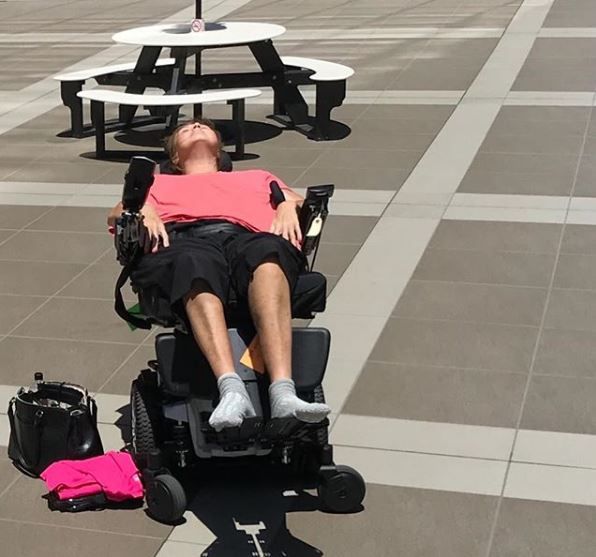Abby Lee Miller, the name that resonates with the world of competitive dance, has been making headlines for reasons beyond the dance floor. Her journey from a fiery dance coach to a woman battling severe health issues has captured global attention. But why can't Abby Lee Miller walk? Let's dive into the details and uncover the truth behind this dance legend's challenges.
When you think of Abby Lee Miller, you envision a woman who commands respect with her sharp words and even sharper dance routines. Her presence on "Dance Moms" turned her into a household name, but life took an unexpected turn. Now, the question that lingers in everyone's mind is why can't Abby Lee Miller walk. This article will explore her journey, the medical conditions affecting her, and the resilience she's shown in the face of adversity.
As we delve deeper into Abby's story, it's essential to understand the broader implications of her condition. It's not just about a celebrity's struggle; it's about human resilience, the importance of healthcare, and the community's role in supporting those in need. So, let's get started and unravel the layers of Abby Lee Miller's life beyond the dance studio.
Read also:Affordable Chic Discover The Best Inexpensive Jean Jackets For Your Wardrobe
Biography of Abby Lee Miller
Early Life and Career
Before we tackle why can't Abby Lee Miller walk, let's take a step back and explore her incredible journey. Abby Lee Miller was born on July 18, 1966, in Pittsburgh, Pennsylvania. Her early life was steeped in the world of dance, and by the age of 13, she had already started teaching dance classes. Her passion for the art form was evident from a young age, and it wasn't long before she established herself as a formidable force in the dance community.
Here's a quick look at Abby Lee Miller's early career:
- Founded the Abby Lee Dance Company in 1995.
- Her dance studio gained fame through the reality TV show "Dance Moms" on Lifetime.
- Became a household name due to her fiery personality and dedication to her students.
Personal Information
Let's take a closer look at Abby Lee Miller's personal life through a table format:
| Full Name | Abby Lee Miller |
|---|---|
| Date of Birth | July 18, 1966 |
| Place of Birth | Pittsburgh, Pennsylvania |
| Profession | Dance Instructor, Choreographer, Reality TV Personality |
| Claim to Fame | Founder of Abby Lee Dance Company and star of "Dance Moms" |
Why Can't Abby Lee Miller Walk?
Understanding the Medical Condition
Now, let's address the elephant in the room: why can't Abby Lee Miller walk? Abby's inability to walk stems from a series of health challenges that have plagued her in recent years. In 2018, she was diagnosed with transverse myelitis, a condition that affects the spinal cord and can lead to paralysis. This autoimmune disorder occurs when the immune system mistakenly attacks the spinal cord, causing inflammation and damage to nerve fibers.
Transverse myelitis is a rare condition, affecting only about 1,400 people in the United States annually. According to the National Institute of Neurological Disorders and Stroke, the exact cause of this condition is often unknown, but it can be triggered by viral infections or autoimmune diseases.
The Journey of Diagnosis
Symptoms and Initial Signs
Abby's journey to understanding why she can't walk began with a series of symptoms that gradually worsened. Initially, she experienced back pain, weakness in her legs, and difficulty maintaining balance. As the condition progressed, she lost the ability to walk entirely. These symptoms are common in transverse myelitis patients and can vary in severity depending on the extent of spinal cord damage.
Read also:How Long Has Cher Been With Her Boyfriend The Untold Story Of Love And Longevity
It's crucial to recognize the early signs of such conditions to seek medical attention promptly. Symptoms may include:
- Severe back pain
- Weakness in the limbs
- Loss of bladder or bowel control
- Sensory changes, such as numbness or tingling
Treatment and Recovery
Medical Interventions
Once diagnosed, Abby underwent various treatments to manage her condition. The primary goal of treatment for transverse myelitis is to reduce inflammation and prevent further damage to the spinal cord. Common treatments include:
- Corticosteroids to reduce inflammation.
- Plasma exchange therapy to remove harmful antibodies from the blood.
- Physical therapy to improve mobility and strength.
While these treatments can help manage symptoms, recovery from transverse myelitis varies from person to person. Some individuals experience partial or complete recovery, while others may face long-term disability.
Abby Lee Miller's Resilience
Fighting Against the Odds
Despite the challenges posed by her condition, Abby Lee Miller has shown remarkable resilience. Her ability to stay positive and continue advocating for dance and the arts is a testament to her strength. She has used her platform to raise awareness about transverse myelitis and the importance of early diagnosis and treatment.
In interviews, Abby has spoken openly about her struggles, emphasizing the need for a strong support system. She encourages others facing similar challenges to remain hopeful and seek the help they need. Her journey is not just about why can't Abby Lee Miller walk; it's about how she continues to inspire others despite her circumstances.
Community Support and Advocacy
Raising Awareness
Abby's story has sparked conversations about the importance of community support and advocacy for those with rare medical conditions. Organizations such as the Transverse Myelitis Association work tirelessly to provide resources and support for patients and their families. By sharing her story, Abby has become a voice for those who may feel isolated or misunderstood.
Her advocacy efforts extend beyond raising awareness; she actively participates in fundraising events and campaigns to support medical research. This involvement highlights the importance of community involvement in addressing health challenges.
The Impact on Her Career
Continuing the Legacy
Abby Lee Miller's career has undoubtedly been affected by her health issues, but her legacy in the dance world remains intact. She continues to inspire her students and fans through her work, proving that passion and dedication can transcend physical limitations.
Her involvement in the dance community has shifted, with a greater focus on mentoring and educating the next generation of dancers. This transition showcases her adaptability and commitment to her craft, answering the question of why can't Abby Lee Miller walk with a story of perseverance and determination.
Lessons from Abby's Journey
Embracing Challenges
Abby Lee Miller's story teaches us valuable lessons about embracing challenges and finding strength in adversity. Her journey from a dance coach to a woman advocating for health awareness is a powerful reminder of the human spirit's resilience.
As we reflect on why can't Abby Lee Miller walk, we must also recognize the importance of empathy, support, and understanding in our communities. Abby's story is a call to action for all of us to stand together and uplift those in need.
Conclusion
In conclusion, the question of why can't Abby Lee Miller walk has a complex answer rooted in medical challenges and personal resilience. Abby's journey from a fiery dance coach to a woman advocating for health awareness is nothing short of inspiring. Her story reminds us of the importance of early diagnosis, community support, and perseverance in the face of adversity.
We encourage you to share this article, leave a comment, or explore other articles on our site. Together, let's continue the conversation about health, resilience, and the power of the human spirit. Remember, Abby Lee Miller's story is not just about why she can't walk; it's about how she continues to inspire millions around the world.
Table of Contents


